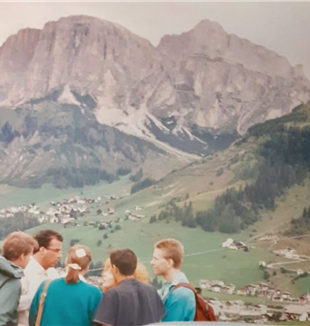
‘Chance’ encounters?
An account of the birth of Communion and Liberation in the UK. Fruit of ‘chance’ encounters, or the whispering of Another?London, Summer 1979. Heraldo, a London born Engineering undergraduate with Italian parents, by ‘chance’ enters one of the local churches in Catford, South East London. There he meets an Italian high-school student from Ancona who was in London to learn English. A friendship begins to flourish, and the two decide to volunteer to help out with the music in the parish. Heraldo gradually gets to know more about the movement to which his friend belongs: Communion and Liberation. A few months later, Anna Maria, an Italian Memor Domini and nurse from Fano, enters the same church ‘by chance’. She spots the song booklets that the two students had prepared, and recognises a song, Povera Voce, often sung within CL; through the parish priest, she is introduced to Heraldo. Until her departure, Anna Maria’s house very quickly becomes a reference point for the many students coming and going from London, including Silvia, Alberto, and Cecilia, also a nurse and a Memores Domini. The friends begin to meet for School of Community, for dinners, and to spend time together, often inviting those met at school or at work.
Cambridge, late 1982. Ana Lydia, a Brazilian Memor Domini novice, moves to Cambridge to begin a doctorate. She, Cecilia, Heraldo, and those students in London at the time begin to meet once a month for School of Community. Cecilia briefly joins Ana Lydia in Cambridge, living with her in a small Memores house. Emilia from Palermo soon also arrives, meeting Ana Lydia at Fisher House, the Catholic Chaplaincy of the University of Cambridge. The two find that they share many friends of CL, and begin to meet for School of Community. In November of that year, following lunchtime Mass, Ana Lydia also meets post-doc John, a Canadian of Italian heritage. Curious about what Ana Lydia and Emilia call “School of Community”, he eventually asks if he can attend.
Fisher House quickly becomes a hub of encounter with other students. Among them are Stefano and Giuseppe, from Rome, in Cambridge from 1984 to begin doctorates. Both had previously met John by ‘chance’ at a CL event in Rome, and they immediately looked for him. A weekend in late 1984, the friends also meet Pino, a Sicilian now working in London; already part of CL in Catania, he was given Heraldo’s details as a point of contact. Heraldo, by ‘chance’, was going up to Cambridge that weekend for a community assembly.
January 1985. Ellis, a Memor Domini from Turin, is sent to Cambridge by Fr. Giussani to accompany Ana Lydia. They begin living together in a small Memores Domini house, which soon becomes a reference point for the many students met at Fisher House. Through Giuseppe and Stefano, the small group of friends soon meet Tom, a half-British half-Roman maths undergraduate. At coffee after Sunday mass, Tom hears Stefano and Giuseppe casually talking in Roman accents. “It was a new way of approaching my Christian faith,” says Tom. “And why were so many people in it? There must have been something worthwhile.” The friends begin to say Vespers, to have dinner together, and to read School of Community.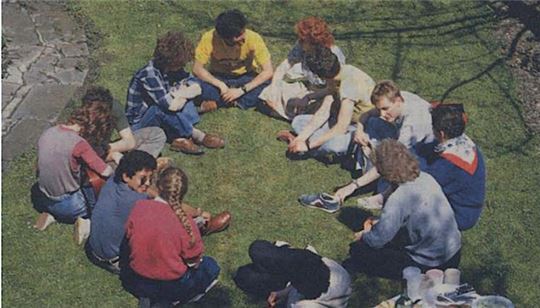
They soon meet Mandy, an English girl studying Italian and French. A few months earlier, whilst staying with an Italian family in Verona, she had ‘by chance’ been invited to the 1985 regional CLU Spiritual exercises preached by Fr. Giussani in Rimini, which kindled her curiosity. Mandy was given Ana Lydia’s contact details, and looking for her finds Ellis at Fisher House. They invited Mandy to to School of Community and begin to spend more time together. “We were reading a text called ‘We belong to a great history.’ Unforgettable, because I thought at one and at the same time – ‘What great history?’ ‘How great to be part of a great history’,” says Mandy. “By Christmas, I was glued to the experience and the community.”
October 1985. At a fresher’s event organised by Fisher House after Sunday’s mass, Mandy abruptly turns around, and ‘accidently’ spills her coffee all over Chris, a second year Law undergraduate. She excuses herself and invites him to meet her friends. Over the course of the year, Chris gets to know Mandy better; he asks her about CL, her friends, and whether he can attend School of Community. Chris remains deeply impressed by the people he meets there. “I felt that they were there for me. They did not want something from me, but offered a different friendship,” he describes.
History begins to repeat itself one summer day in 1986, again at coffee after Mass. Mandy and Giuseppe get talking with Juliet, an English girl studying Russian and Spanish, and invited her to say Vespers together. “I was struck, when we said Evening Prayer, by the reverence and care with which they said – or sang – it in a way I had never heard before. I was surprised by their warmth and friendliness,” says Juliet. She also gets to know other friends of theirs Dominic G, Chris K, Manuel, and Daniela from Rome. “I remember asking them at one point what this movement, Communion and Liberation, was that they belonged to? And what I sort of understood at that point was that it was essentially a friendship – with Christ inside it!”
Many faces begin to come and go. Juliet leaves for a year abroad in Russia, and Chris graduates, moving to Guilford to undertake law exams. This new friendship, however, is never far away. “I remember being struck by letters I received from Mandy while I was out in Moscow,” recounts Juliet. “The way she described the beauty of life around her in Cambridge struck me. She definitely saw everything in life in a beautiful way.” Newly arrived in Cambridge is Joe, a music student and Chris’ younger brother, who first meets Mandy and the rest of the little community at Fisher House; Brigid; Antonio; Alceste; Floriana; and François. "There was a strong sense of belonging which pretty much turned my life around at the time,” describes Brigid.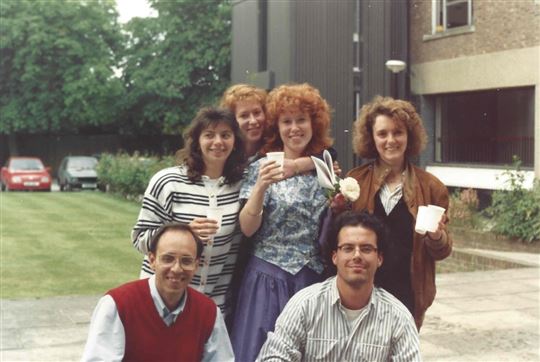
What brought these students together was a friendship that was vibrant and alive, rooted in community life. “Throughout those years in Cambridge, He never gave up whispering to me, although I had my eyes and heart fixed elsewhere. His whispering to me at university is where I feel my adult relationship with Christ began,” describes Juliet. An essential part of the friendship became the praying of Vespers together each evening. “It gave a rhythm to our lives. The movement introduced us to a prayer life, which nourished the friendship, which was in turn animated by this discovery of being part of the church in a way that was so much more than your local experience,” recounts Mandy.
Cooking, eating and singing together were also important experiences of unity in the friendship, allowing the trust and faith that came to forge all their lives to bloom. School of Community became a natural progression of those shared moments together, becoming “a concrete opportunity to share and judge our life with our friends, such a novelty when compared to the experience of it in Rome, with hundreds of students attending. Moving to Cambridge gave me the chance to make a real experience of the value of the Movement in my life”, says Daniela.
York, October 1988. History repeats itself. Gianmaria, an Italian Economics graduate from Milan, arrives with his wife Lorella, and Pablo, a Chilean living in Milan. They immediately get involved with the university’s Catholic Chaplaincy. Roger, a physics fresher, also begins his studies in York, as does Scottish Jackie - who has actually already met Chris ‘by chance’ the previous year in Guilford. Roger befriends two Catholic girls and begins to attend the chaplaincy. One of the first events proposed by the chaplaincy ‘happens’ to be a presentation by Gianmaria and Lorella about Communion and Liberation, after which Roger starts attending School of Community. Jackie too is invited after a dinner with Gianmaria and Lorella. “I was struck by the way they listened and took action. It was a faith that was in action,” recounts Jackie. This marked the beginning of a very simple everyday friendship in which, together with Gianmaria, Frank and other friends, they would meet to say the Angelus, for lunch together, for dinners and song evenings. “It was a very simple way of spending time together. They brought the faith that I had been brought up with into daily life, and that coloured everything they did,” describes Roger.
September 1989. Roger signs up to act as chaplaincy volunteer to greet incoming freshers by knocking on their bedroom doors. One of the doors he knocks on belongs to Amos, a maths undergraduate. Amos gets to know Roger’s Italian friends and eventually begins to go to School of Community. “People had said to me that I needed a companionship for my relationship with Christ. I saw that these people were living the Catholic life but enjoying life,” says Amos. Dominic, a chemistry fresher, also begins to go to Sunday mass at the chaplaincy. His first mass in York is followed by the announcement that a football match will take place in the afternoon, followed by tea and songs. There he meets Gianmaria and Pablo for the first time, and they invite him to have lunch with them everyday.
After a month, Gianmaria and Roger invite Dominic and Amos to dinner with some friends from Cambridge, including Joe and Antonio. They soon meet John, a school friend of Joe. “It was a change from being a cradle Catholic to being part of something that was part of everyday life,” describes John. Soon after they make the trip down to Cambridge for the Beginning of the Year Day, led by Guido, a visitor from Italy. “I began to see that their faith was alive, alive in everything. For them, all of life was exciting and passionate,” says Dominic.
Gradually, the friendship between this group of students begins to pervade every aspect of daily life. John, Amos, Dominic and Frank decide to share a house, eating and studying together, participating in chaplaincy events, going to Mass together followed by a pub lunch, walks and football. “There was a real unity and beauty. These were people to accompany me in faith, but within normal real life,” describes Amos.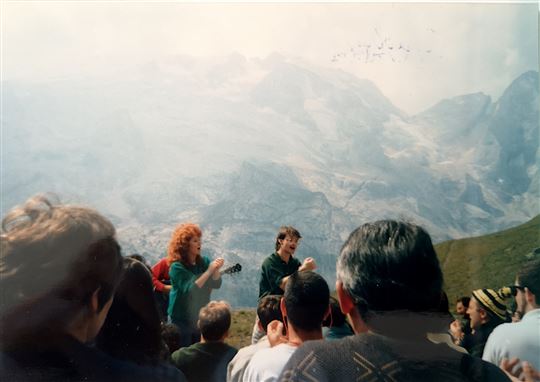
In these years, the friends spread between York, Cambridge and London are invited to attend the CL International Holiday in the Dolomites in Italy, their first real encounters with Fr. Giussani. “Seeing so many priests and bishops come to say Mass, we could perceive how it was bigger and not just centered on our little relationship. We were clearly part of the universal church,” recounts Roger. Amos adds, however, that “real community life really started when we got back – studying, eating together. It was a life together that grew and grew, and there became no separation between the life of faith and our life at university.”
London, 1987. Community life begins to mature. Pino and Heraldo start living together, later joined by Giustino. Fr. Bernardo and Fr. Lucio, PIME missionaries in London, also soon meet John C in a Catholic Church in Whitechapel. The friends attend Sunday Mass at Westminster Cathedral, eating together afterwards, and this soon becomes a key point of encounter for new people coming to London who searched for the companionship of CL. “I remember Emilia invited me to meet up with her and some friends in London after Mass outside Westminster Cathedral. I said yes. And that was when I feel I really had my first experience of Christ, face to face, with my eyes and heart wide open,” recounts Juliet.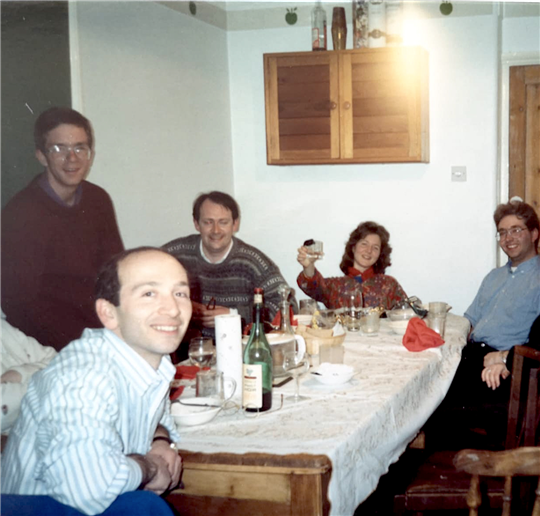
Towards the end of the 80s and the beginning of the 90s, those studying in York and Cambridge gradually gravitated towards London for work or further study; the London community thus began to increasingly evolve, as did a more adult, communal life. Many of the community – Roger, Emilia, Chris, Juliet, Pino and John B – began to truly share every day life by deciding to live together. This pattern continued over the next years; Chris, Pino, John, Roger and Amos moved around the corner from Juliet, Emilia and Jackie. “We would always have dinner together,” recounts Amos. “Even the simple things of sharing our life together was something exceptional.” This went even beyond the communal life experience at university, as Jackie explains, because “this became a stronger experience of sharing a working life, grounded on the basis of living together, judging situations and problems.”
Cambridge, 1990s. Community life also continues to flourish. In 1992, Eleanor, a humanities student, finds out that a group of Catholics living in her accommodation are involved with Fisher House. “It was 1992, when the Anglican synod voted to allow women to study for the priesthood. I asked one of my housemates to take me to Mass, to see what the chaplain would say about this news story,” recounts Eleanor. The chaplain does not comment but Eleanor is invited to join the Fisher House choir. “At first, my reasons for going to Mass were social and friendly, but over the months the relationship with the Mass itself became more and more important to me. I realised that something had moved within me.” Soon, Carlo, a visiting student from Italy, invites her to School of Community. The value of this companionship for Eleanor was witnessed by her decision to be baptised at Fisher House in May 1994, accompanied by friends of the community.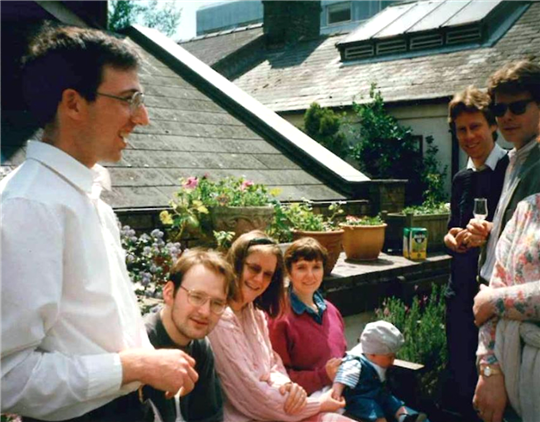
The North of England, 1990s. In 1993, Michelle, living in Birmingham, is invited by her school friend Jackie to dinner in London where she meets Jackie’s friends in the community. “I witnessed a change in Jackie, and in our friendship. I became interested in what was behind the change,” recounts Michelle. In Manchester, in 1995, Ciro, an Italian Economics Master’s student, meets two Italian Erasmus students, Andrea and Stefano. Again, they begin to go to Mass together at the Catholic chaplaincy, to eat together, and to go to the pub with other students on their courses. A friendship flourishes and together they begin a small group of School of Community in the chaplaincy, also going down to London once a month to spend the day with other students of the community – Mass, lunch, a testimony, games in the park and an evening film.
From there, a truly UK CL community gradually began to plant its roots, maturing from a community of students and young workers who were coming and going, to a stable adult community. Many couples then get married, settling in Cambridge, London, and outskirts. In 1994, the first Memores Domini House is opened in Ealing in London, becoming a point of reference for the growing community. 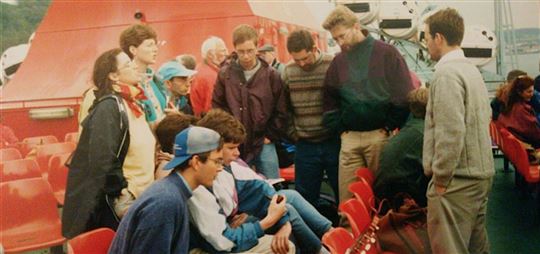
Thirty, even almost forty years later, these initial ‘chance’ encounters, fruit of a friendship that evidently belonged and belongs to Another, continues to flourish and mature. “Throughout these years I have truly discovered companionship,” describes Emilia. The word companionship is pregnant with meaning: “The movement has been a path to familiarity with Christ, I have come to know Christ through a companionship,” says Amos.